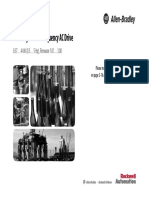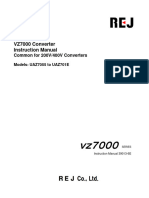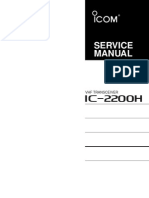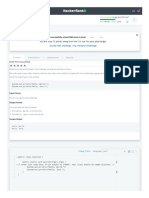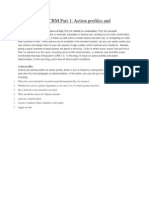Instructions Manual EVR IMEV900002
Instructions Manual EVR IMEV900002
Uploaded by
Ivan Dario QuirogaCopyright:
Available Formats
Instructions Manual EVR IMEV900002
Instructions Manual EVR IMEV900002
Uploaded by
Ivan Dario QuirogaCopyright
Available Formats
Share this document
Did you find this document useful?
Is this content inappropriate?
Copyright:
Available Formats
Instructions Manual EVR IMEV900002
Instructions Manual EVR IMEV900002
Uploaded by
Ivan Dario QuirogaCopyright:
Available Formats
IM-EV9-00002 For more information visit: www.cutler-hammer.eaton.
com
Electronic Voltage Regulator (EVR)
Instruction Manual
New Information
For more information visit: www.cutler-hammer.eaton.com IM-EV9-00002
Instruction Manual
Page
2
Effective: November 2002
Electronic Voltage Regulator
(EVR)
Proprietary Reproduction or
Distribution Forbidden
NOTICE: THIS DOCUMENT
CONTAINS PROPRIETARY
INFORMATION
This document contains proprietary
and condential information of the
Cutler-Hammer business. In consider-
ation of the receipt of this document,
the recipient agrees not to copy any
of its contents, nor disclose them
to or allow them to be used by any
person not currently an employee
of the Cutler-Hammer business or
an employee of the recipient having
a need to know, without the express
written consent of the Cutler-Hammer
business, and further agrees to
surrender this document to the Cutler-
Hammer business when the reason
for its receipt has terminated.
Safety precautions are important
when operating or servicing electrical
equipment. The following symbols
are used extensively throughout this
manual. Always heed these precautions
since they are essential to the safe
operation and servicing of this product.
This danger symbol identies a
condition or action which will result in
severe injury or death to an individual
or severe damage to equipment or
other property.
This caution symbol identies a
condition or action which may result in
minor injury to an individual or minor
damage to the equipment or other
property.
This unit was designed for specic
applications. It should not be modied
and/or used for any application other
than for that which it was designed.
Optional equipment not described in
the sales literature or this manual
should not be installed without rst
checking with the service department.
If you have any questions about this
units application call the service
department at (403) 717-2000.
SAFETY
DANGER
CAUTION
IM-EV9-00002 For more information visit: www.cutler-hammer.eaton.com
Instruction Manual
Effective: November 2002 Page
3
Electronic Voltage Regulator
(EVR)
Table of Contents
Description Page
Section 1 Operation. . . . . . . . . . . . . . . . . . . . . . . . . . . . 5
1.1 Introduction. . . . . . . . . . . . . . . . . . . . . . . . . . . . .
5
1.1-1 EVR. . . . . . . . . . . . . . . . . . . . . . . . . . . . . . .
5
1.2 Benets . . . . . . . . . . . . . . . . . . . . . . . . . . . . . . . .
5
1.3 Transformer . . . . . . . . . . . . . . . . . . . . . . . . . . . . .
5
1.4 Product Features . . . . . . . . . . . . . . . . . . . . . . . . .
6
1.4-1 Bypass Switch . . . . . . . . . . . . . . . . . . . . . .
7
1.4-2 Input and Output Power Terminals . . . . .
7
1.4-3 Input Filter . . . . . . . . . . . . . . . . . . . . . . . . .
8
1.4-4 Output Filter. . . . . . . . . . . . . . . . . . . . . . . .
8
1.5 Regulation Components. . . . . . . . . . . . . . . . . . .
8
1.6 Starting the Unit . . . . . . . . . . . . . . . . . . . . . . . . .
10
1.7 Operation. . . . . . . . . . . . . . . . . . . . . . . . . . . . . . .
10
1.7-1 Normal Condition . . . . . . . . . . . . . . . . . . .
10
1.7-2 Nonregulating Condition . . . . . . . . . . . . .
10
Section 2 Preinstallation . . . . . . . . . . . . . . . . . . . . . . . . 11
2.1 Location Considerations. . . . . . . . . . . . . . . . . . .
11
2.2 Floor Loading . . . . . . . . . . . . . . . . . . . . . . . . . . .
11
2.3 Cable Access and Floor Layout . . . . . . . . . . . . .
11
2.3-1 Cable Access . . . . . . . . . . . . . . . . . . . . . . .
11
2.4 Mounting . . . . . . . . . . . . . . . . . . . . . . . . . . . . . . .
11
Section 3 Installation. . . . . . . . . . . . . . . . . . . . . . . . . . . 13
3.1 Installation. . . . . . . . . . . . . . . . . . . . . . . . . . . . . .
13
3.1-1 Unpacking . . . . . . . . . . . . . . . . . . . . . . . . .
13
3.1-2 Inspection . . . . . . . . . . . . . . . . . . . . . . . . .
13
3.1-3 Input Cable Installation. . . . . . . . . . . . . . .
13
3.1-4 Output Cable Installation . . . . . . . . . . . . .
14
3.1-5 EVR Startup . . . . . . . . . . . . . . . . . . . . . . . .
14
3.1-6 Calibrate Control Logic Board . . . . . . . . .
14
3.2 Conguration . . . . . . . . . . . . . . . . . . . . . . . . . . .
16
3.3 Renewal Parts . . . . . . . . . . . . . . . . . . . . . . . . . . .
16
3.3-1 Vendor Parts List . . . . . . . . . . . . . . . . . . . .
16
Section 4 Options . . . . . . . . . . . . . . . . . . . . . . . . . . . . . 17
4.1 Introduction. . . . . . . . . . . . . . . . . . . . . . . . . . . . .
17
4.2 Surge Protection . . . . . . . . . . . . . . . . . . . . . . . . .
17
4.3 Input/Output Filtering . . . . . . . . . . . . . . . . . . . . .
17
Appendix A Specications . . . . . . . . . . . . . . . . . . . . 19
Glossary. . . . . . . . . . . . . . . . . . . . . . . . . . . . . . . . . . . . . . 19
Index of Figures and Tables
Description Page
Figures
Section 1 Operations
1-1 Regulated System Response. . . . . . . . . . . . . . .
5
1-2 EVR (10 1250 kVA) . . . . . . . . . . . . . . . . . . . . . .
5
1-3 EVR 15 kVA 150 kVA, 480V ac Input . . . . . . . .
6
1-4 EVR 175 kVA 300 kVA, 208V ac Input . . . . . . .
7
1-5 EVR 175 kVA 300 kVA, 208V ac Input . . . . . . .
7
1-6 Input Filter Wiring . . . . . . . . . . . . . . . . . . . . . . .
8
1-7 Output Filter Wiring . . . . . . . . . . . . . . . . . . . . . .
8
1-8 Regulation Panel Assembly Layout . . . . . . . . .
8
1-9 Regulation Panel Assembly Layout . . . . . . . . .
9
1-10 Regulation Block Diagram. . . . . . . . . . . . . . . .
9
Section 2 Preinstallation
2-1 EVR Cable Access. . . . . . . . . . . . . . . . . . . . . . . .
11
2-2 EVR Clearances. . . . . . . . . . . . . . . . . . . . . . . . . .
11
Section 3 Installation
3-1 Control Logic Board . . . . . . . . . . . . . . . . . . . . . .
15
3-2 SCR Driver Board . . . . . . . . . . . . . . . . . . . . . . . .
15
3-3 EVR 15 kVA 150 kVA, 480V ac
Vendor Part List . . . . . . . . . . . . . . . . . . . . . . . . .
16
Section 4 Operations
4-1 Input Filter Wiring . . . . . . . . . . . . . . . . . . . . . . .
17
4-2 Output Filter Wiring . . . . . . . . . . . . . . . . . . . . . .
17
Tables
1-1 Product Features . . . . . . . . . . . . . . . . . . . . . . . .
6
2-1 EVR Site Planning Specications . . . . . . . . . . .
11
2-2 kVA Rating and Dimensions . . . . . . . . . . . . . . .
11
2-3 EVR Floor Loading . . . . . . . . . . . . . . . . . . . . . . .
11
3-1 Vendor Parts List. . . . . . . . . . . . . . . . . . . . . . . . .
16
3-2 EVR Specications . . . . . . . . . . . . . . . . . . . . . . .
19
For more information visit: www.cutler-hammer.eaton.com IM-EV9-00002
Instruction Manual
Page
4
Effective: November 2002
Electronic Voltage Regulator
(EVR)
This page intentionally left blank.
IM-EV9-00002 For more information visit: www.cutler-hammer.eaton.com
Instruction Manual
Effective: November 2002 Page
5
Electronic Voltage Regulator
(EVR)
Section 1: Operation
1.1 Introduction
This manual provides installation,
operation and maintenance informa-
tion for Eatons Cutler-Hammer
Electronic Voltage Regulator (EVR). A
detailed description of each product is
provided in the following subsections.
All components used are of the high-
est quality and specically selected
to achieve the highest level of perfor-
mance. These units are UL
listed and
conform to National Electrical Code
(NEC
) and Occupational Safety and
Health Act (OSHA) standards.
The EVR has tapped electronic voltage
regulators. Six taps are on each pri-
mary winding of the transformer. Each
tap is controlled by a silicon-controlled
rectier (SCR) switch and can become
active at any time. Input line-to-line
voltage and line current are monitored
for each phase. Peak voltage is
compared with a desired reference.
Depending on this comparison, the
regulation logic activates the proper
SCR switch when the phase current
becomes zero. This changes the pri-
mary-to-secondary turns ratio which
corrects output voltage to the desired
nominal. The correction process starts
in less than one cycle. See
Figure 1-1
.
Figure 1-1. Regulated System Response
Corrected
in 1 Cycle
Corrected
in 1 Cycle
Power-Regulated,
Regulated to +/- 3% of Nominal Typical
Sag
Surge
500
480
420
-480
0
480
-480
0
Input
Output
1.1-1 EVR
The EVR is designed to provide the
reliable, high-quality power necessary
to meet the needs of todays sensitive
electronics.
These three-phase, 60 Hz, self-con-
tained, modular units provide isolation
and regulation of ac power. The zero-
current tap switching voltage regula-
tion circuitry automatically adjusts for
an input voltage range between +10%
surge and -26% sag about the nominal
rated voltage with an output voltage
range of 3% typical to 4% maxi-
mum. Each phase is regulated inde-
pendently.
The EVR is available in input voltages
of 208 or 480V ac and output voltages
of 208Y/120 and 480Y/277V ac. These
units are available in sizes ranging
from 10 kVA to 1250 kVA. The specic
rating information for your unit is pro-
vided on the label plate located on the
front panel. Refer to
Appendix A
.
The EVR unit is shown in
Figure 1-2
.
Figure 1-2. EVR (10 1250 kVA)
1.2 Benets
The EVR protects electronic equipment
from an overvoltage condition during
line power surges and an undervolt-
age condition during sags. In addition,
the unit protects equipment load
by attenuating transients present
on utility power lines. Overvoltage,
overcurrent and transient conditions
stress electronic components and
decrease system reliability.
In medical applications, voltage
uctuations affect the image quality
of imaging systems. Artifacts are intro-
duced under sag conditions. Regulat-
ing power maintains image quality,
resulting in more consistent images.
1.3 Transformer
The transformer contained in the unit
is designed for convection cooling
by means of free circulation of air
through the bottom, front and back of
the unit. Maximum ambient tempera-
tures should not exceed 104F (40C).
The transformer contains built-in ther-
mal sensors which monitor internal
temperatures. In models with an Input
Main Circuit Breaker (IMCB), the ther-
mal sensors send a shunt trip signal
to the IMCB in the event of an over-
temperature condition.
For more information visit: www.cutler-hammer.eaton.com IM-EV9-00002
Instruction Manual
Page
6
Effective: November 2002
Electronic Voltage Regulator
(EVR)
1.4 Product Features
Sections 1.4
and
1.5
describe the
features of the EVR. Some features
described in
Section 1.4
are standard
on all models while other features are
offered as options. Refer to
Table 1-1
to determine if the features described
in this section are applicable to your
unit. Refer to
Section 4
, Options, for
information on optional features.
Table 1-1. Product Features
Table Key:
S = Standard equipment.
O= Available as an option.
Option Model EVR
Bypass Switch
Input Filter
Output Filter
Input/Output Power Terminals
S
S
O
S
Figure 1-3. EVR 15 kVA 150 kVA, 480V ac Input
Input Power Filter
Main Power
Transformer
Input & Output
Power Terminal
Regulation
Electronic Panel:
Heat Sinks
SCR Snubber Boards
SCR Power Blocks
Reference Transformers
SCR Driver Boards
SCR Control Boards
Fuses
Bypass Switch
Input & Output
Cable Access
(Both Sides)
9/16" Diameter
Mounting Holes
Output Filter
(Optional)
IM-EV9-00002 For more information visit: www.cutler-hammer.eaton.com
Instruction Manual
Effective: November 2002 Page
7
Electronic Voltage Regulator
(EVR)
Figure 1-4. EVR 175 300 kVA, 208V ac Input
Figure 1-5. EVR 175 300 kVA, 208V ac Input
Input
Filter
Regulation
Electronics
Panel
Output
Filter
Bypass
Switch
Input & Output
Cable Access
(Both Sides)
Fans for
Electronic
Cooling
Fan Fuse
9/16" Diameter
Mounting Holes
Main Power
Transformer
Output Power
Terminals
Input Power
Terminals
Bypass Switch
Input & Output
Cable Access
(Both Sides)
Main Power
Transformer
Input Auto
Transformer
Input
Filter
Regulation
Electronic
Panel
Output
Filter
Fans for
Electronic Cooling
Fan Fuse
9/16" Diameter
Mounting Holes
Output Power
Terminals
Input Power
Terminals
1.4-1 Bypass Switch
The bypass switch is located on the
front panel. See
Figures 1-3
through
1-5
. This switch bypasses voltage reg-
ulation but maintains the functioning
of the voltage change/isolation trans-
former between input and output.
In AUTO position, line-to-neutral volt-
ages are regulated. In MAN (manual)
position, regulation logic is bypassed
and input power is applied to load via
transformer without regulation. Select
the MAN position if there is a problem
with regulation logic circuitry. Refer
to
Section 1.7-2
, Nonregulating Condi-
tion for the procedure to operate the
unit in bypass mode.
1.4-2 Input and Output Power Terminals
Input and output power connections
are made at the terminals located
beneath the transformer except in
Figures 1-6
and
1-7
where the termi-
nals are located above and to the rear
of the main transformer. Terminals are
labeled H1, H2, H3, or L1, L2, L3 for
the input cable connections, and X0,
X1, X2, X3 for the output cable
connections.
CAUTION
The Bypass Switch must never be
changed with the unit powered up
.
For more information visit: www.cutler-hammer.eaton.com IM-EV9-00002
Instruction Manual
Page
8
Effective: November 2002
Electronic Voltage Regulator
(EVR)
1.4-3 Input Filter
The input lter is installed on the
primary side of the transformer.
The input lter consists of a resistor/
capacitor network which acts as a
large snubber circuit to eliminate high
frequency impulses from entering the
power system. See
Figure 1-6
.
1.4-4 Output Filter
The output lter is installed on the
transformer secondary. It consists of
a capacitor network which prevents
noise from being fed back to the
unit from noise generating loads.
See
Figure 1-7
.
1.5 Regulation Components
Regulation is accomplished by solid-
state electronics which control the
tap switching function at the zero-
current-crossing.
The regulation components are
mounted on the regulation panel and
can be seen by removing the front
panel. See
Figures 1-8
and
1-9
. The
regulation components include three
SCR control logic boards, three SCR
driver boards, 18 SCR/SCR snubber
board assemblies, three current trans-
formers, three reference transformers,
and three heatsinks. See
Figure 1-10
for a block diagram of the regulation
panel components.
Each SCR control logic board has
seven LEDs. The rst six LEDs indicate
the active tap selection during opera-
tion. LED 7 indicates power is applied
to the board and is always lit during
operation.
Figure 1-6. Input Filter Wiring Figure 1-7. Output Filter Wiring
Figure 1-8. Regulation Panel Assembly Layout
H1
H2
H3
(L1)
(L2)
(L3)
R3
R2
R1
R6
R5
R4
C1
C2
C3
X0
X3
X2
X1
C6
C5
C4
665544332211665544332211665544332211
Heatsink (3)
SCR (18)
Fuselink (15)
SCR Snubber
Board (18)
SCR Driver
Board (3)
Fuses for
Ref. Transformer (3)
(Not on All Models)
Reference
Transformer (3)
To Current
Transformer
To Current
Transformer
To Current
Transformer
To Bypass To Bypass To Bypass
SCR Control
Logic Board (3)
IM-EV9-00002 For more information visit: www.cutler-hammer.eaton.com
Instruction Manual
Effective: November 2002 Page
9
Electronic Voltage Regulator
(EVR)
Figure 1-9. Regulation Panel Assembly Layout
Figure 1-10. Regulation Block Diagram
Note:
On EVR, Tap 5 of the transformer is selected.
To Current
Transformer
To Current
Transformer
To Current
Transformer
Heatsink (3)
SCR (18)
SCR Snubber
Board (18)
Fuselink (15)
SCR Driver
Board (3)
Fuses for
Ref. Transformer (3)
Fuses For
Fan (3)
Reference
Transformer (3)
SCR Control
Logic Board (3)
1
4
Current
Xfmr
Input
Input
Fusewire
(5 Times)
Buck-Boost
Transformer
Output
Main Tap Changer
Transformer (3)
P1
P2
P1
SCR/
Snubber
Board
(6 Times)
Fuse
P3
Bypass
Switch
Manual
Auto
3
Reference
Transformer
SCR
Driver
Board
Control
Logic
Board
4 Wires
8 Wires
For more information visit: www.cutler-hammer.eaton.com IM-EV9-00002
Instruction Manual
Page 10 Effective: November 2002
Electronic Voltage Regulator
(EVR)
1.6 Starting the Unit
This procedure is to be used only for
starting the unit during the normal
course of operation. Follow this oper-
ating procedure any time the unit has
been turned off in a non-emergency
situation.
1. Verify that Bypass Switch is set
to AUTO.
2. Verify that connected load is OFF.
3. Energize facility branch circuit
breaker.
4. Close front door.
5. Turn ON connected load.
1.7 Operation
This unit is designed for unattended
continuous operation. Units that have
an IMCB can be switched ON and OFF
on a regular basis using the IMCB as
a switch.
1.7-1 Normal Condition
The normal operating condition of the
unit is as follows:
1. Facility branch circuit breaker set
to ON.
2. Bypass switch in AUTO position.
3. IMCB ON (if applicable).
4. Connected load set to ON.
K If Power Island connected, output
panelboard circuit breakers ON
(as required).
1.7-2 Nonregulating Condition
In case the regulating circuits fail to
regulate, the unit can continue to oper-
ate in bypass mode (without regula-
tion) until regulation can be restored.
Follow the procedure listed below to
operate the unit in bypass mode.
Note:The following procedure is only for
temporary operation. Voltage surge and
sag protection is not available for any load
while the bypass switch is in manual mode
(bypass switch is set to MAN).
1. Turn connected load OFF.
2. Set facility branch circuit breaker
to OFF.
3. Set IMCB to OFF (if applicable).
4. Turn bypass switch from AUTO
to MAN.
5. Set facility branch circuit breaker
to ON.
6. Set IMCB to ON (if applicable).
7. Turn connected load ON.
8. Refer to manufacturers service
personnel.
CAUTION
If this is the initial startup or if the
unit has been moved, perform the
startup procedure in Section 3.1-5
before applying power to the unit.
CAUTION
If the unit is connected to a power
island modular distribution center,
verify that all panelboard output
circuit breakers are off before turning
on branch feeder circuit breaker.
IM-EV9-00002 For more information visit: www.cutler-hammer.eaton.com
Instruction Manual
Effective: November 2002 Page 11
Electronic Voltage Regulator
(EVR)
Section 2: Preinstallation
2.1 Location Considerations
Operating Environment: Provide an operating environment
which meets the following conditions:
I Ambient temperature: 32 104F (0 40C).
I Relative humidity: 10% 90% (noncondensing).
Positioning: Position the unit so that the regulating electron-
ics are not obstructed by objects that could make servicing
the unit difcult. Allow minimum service access clearances
as dened in Figure 2-2.
This unit is air cooled by convection. Do not block air ow
from the front, rear or bottom of the unit.
Table 2-1.EVR Site Planning Specications
Table 2-2.kVA Rating and Dimensions
2.2 Floor Loading
Sizes and weights of units are listed in the following tables.
Provide a oor with strength sufcient for loads specied.
Table 2-3. EVR Floor Loading
Note:Contact factory for >300 kVA.
2.3 Cable Access and Floor Layout
2.3-1 Cable Access
Cable access to the EVR, sizes 100 to 300 kVA, is through
a 4-inch (101.6 mm) diameter hole in the right and left sides
of the unit through which the input and output cables can be
passed. Cable access to the EVR, sizes 10 to 75 kVA is through
an opening in the left and right side of the unit. See Figure 2-1.
Figure 2-1. EVR Cable Access
2.4 Mounting
The EVR is equipped with angle-iron feet that have four
9/16-inch (14.3 mm) diameter holes pre-drilled for mounting.
Units can be bolted to the oor using these mounting holes.
Figure 2-2. EVR Clearances
Nominal Input Voltage (V) 208 480
Input Voltage Range (V) 154 229 355 528
Maximum Input Voltage (V) 229 528
Frequency (Hz) 60
Ambient Temperature F (C) 104 (40)
kVA Weight in
Lbs. (kg)
BTUs/HR Dimensions H x W x D
in Inches (mm)
10
20
30
400 (182)
450 (204)
500 (227)
2040
3050
4080
32.0 x 26.5 x 17.0 (813 x 673 x 432)
32.0 x 26.5 x 17.0 (813 x 673 x 432)
32.0 x 26.5 x 17.0 (813 x 673 x 432)
50
75
100
700 (318)
850 (386)
1000 (454)
6800
10,200
13,600
40.5 x 31.5 x 22.0 (1029 x 800 x 559)
40.5 x 31.5 x 22.0 (1029 x 800 x 559)
40.5 x 31.5 x 22.0 (1029 x 800 x 559)
150
200
250
1100 (499)
2000 (908)
2450 (1112)
17,000
27,200
34,000
51.5 x 40.5 x 26.5 (1308 x 1029 x 673)
66.0 x 50.5 x 32.0 (1676 x 1283 x 813)
66.0 x 50.5 x 32.0 (1676 x 1283 x 813)
300
400
500
2900 (1317)
3900 (1771)
4250 (1930)
40,800
50,700
60,600
66.0 x 50.5 x 32.0 (1676 x 1283 x 813)
73.0 x 67.0 x 35.0 (1854 x 1702 x 889)
73.0 x 67.0 x 35.0 (1854 x 1702 x 889)
600
750
875
6500 (2951)
7500 (3405)
8500 (3859)
70,400
80,800
90,600
73.0 x 67.0 x 35.0 (1854 x 1702 x 889)
73.0 x 67.0 x 35.0 (1854 x 1702 x 889)
73.0 x 67.0 x 35.0 (1854 x 1702 x 889)
1000
1250
9500 (4313)
10,500 (4767)
99,600
105,000
73.0 x 100.0 x 35.0 (1854 x 2540 x 889)
73.0 x 100.0 x 35.0 (1854 x 2540 x 889)
kVA
Size
Input
Voltage
Floor Loading
Lbs/ft
2
(kg/m
2
)
kVA
Size
Input
Voltage
Floor Loading
Lbs/ft
2
(kg/m
2
)
10 208
480
128 (628) 150 208
480
129 (489
161 (788)
30 480 160 (788) 200 208
480
179 (662)
134 (497)
50 208
480
146 (710)
75 480 176 (862) 250 208
480
220 (811)
161 (597)
100 208
480
108 (414)
208 (1013)
300 208
480
260 (960)
175 (646)
Front View
Input/Output
Cable Entrance
Left Side View Right Side View
14"
(35.6)
26.5"
(67)
14"
(35.6)
Top View
Front View
Service Access
Space Required
Note:
17"
(43)
38"
(96.5)
32"
(81.3)
All Dimensions are
in Inches (centimeters)
Indicates Air Flow
Side View
14"(35.6)
Weight 520 lbs. (236 kg)
Floor Loading 1061 lbs/sq.ft.
For more information visit: www.cutler-hammer.eaton.com IM-EV9-00002
Instruction Manual
Page 12 Effective: November 2002
Electronic Voltage Regulator
(EVR)
This page intentionally left blank.
IM-EV9-00002 For more information visit: www.cutler-hammer.eaton.com
Instruction Manual
Effective: November 2002 Page 13
Electronic Voltage Regulator
(EVR)
Section 3: Installation
3.1 Installation
Install unit using the procedures in
this section. Final installation must be
in accordance with NEMA standards
and conform to local electrical codes
as appropriate.
3.1-1 Unpacking
Unit is shipped on a pallet, secured
with metal bands and can be handled
using a fork lift or pallet jack.
1. Position the container away from
walls or other obstructions.
2. Cut metal shipping bands.
3. Remove cardboard cover. Avoid
puncturing the cardboard cover
with sharp objects which may
damage the surface of the unit.
4. Remove the unit from the pallet.
EVR can be removed using
fork lift.
5. Remove protective plastic lm.
6. Inspect unit for damage per
Section 3.1-2, Inspection.
7. Move unit to installation site.
8. Before nal positioning of unit,
verify that all cable routing con-
duit and raceway is positioned
properly.
3.1-2 Inspection
Perform the following inspection pro-
cedure of the unit to check for obvious
damage or safety hazards that may
have occurred during shipping or
handling of the unit. All units must
be inspected when received and again
prior to use. Any damage must be
reported immediately to the Cutler-
Hammer business or an authorized
representative. Freight damage claims
should be initiated with the carrier.
1. Inspect all external surfaces (panels,
covers, etc.) for abrasions, indenta-
tions, or other obvious damage.
2. File a claim with shipping agency for
any damage caused by shipping.
3. Forward a copy of damage claim
to the Cutler-Hammer business.
3.1-3 Input Cable Installation
EVR 10 300 kVA
The customer-furnished input power
cable provides power from the building
power source to the unit. Both the circuit
and this cable should be dedicated to
providing power only to this unit. This
cable must include three power conduc-
tors and an insulated ground conductor.
Size the cable to suit the unit kVA rating,
the input voltage and the overall length
of the cable. The input power cable size
and installation must be in accordance
with the National Electrical Code (NEC)
and applicable local requirements.
A parity sized ground, with respect to
the primary input conductors is recom-
mended. The grounding conductor is
to be grounded to earth at the service
equipment or other acceptable true
building ground.
The unit has one 4-inch (101.6 mm)
diameter hole in each side of the frame
to accommodate the input and output
power cables. There are no holes in the
side panels. The holes in the panels can
be sized, located and punched or drilled
when the cable is installed. The input
power cable can be connected through
the left or right side of the unit.
If cables are crossed or wires are likely
to touch, insulating sleeves or their
equivalent must be used to prevent
wires from touching.
I Tools required:
K phase rotation meter
Procedure:
1. Turn facility circuit breaker to OFF,
lock and tagout in accordance
with OSHA Lockout/Tagout
requirements.
2. Remove top cover by unbolting
two bolts on each side of cover.
3. Remove front panel by unbolting
six bolts at corners and at left and
right sides of panel.
4. Punch or drill a hole in side panel.
Locate hole so that it aligns with
existing hole in frame. See Figure
2-2. Size hole to suit cable/conduit.
5. Insert cable/conduit through hole
in panel and into hole in frame.
Secure with appropriate tting.
6. Prepare cable ends by removing
3/4-inch of insulation from each
input power cable conductor.
7. Identify each phase conductor
according to phase A, B, C.
Identify ground conductor.
8. Route and connect phase conduc-
tors to input terminals on input
labeled H1, H2 and H3 or L1, L2 and
L3. See Figures 1-2 and 1-3.
9. Locate ground lug on side of
cabinet.
10. Route and connect ground con-
ductor to ground lug.
11. Proceed to Section 3.1-4 for
instructions to install output
power cable.
DANGER
Cut metal bands carefully. They are
under tension and may cause injury.
CAUTION
Unit weighs from 400 lbs (181 kg)
to 3,500 lbs (1,588 kg) including the
packaging. Plywood or steel plates
may be used to distribute weight
and protect oor surface from
overload damage.
CAUTION
Do not connect unit to building
power until the following procedure
has been completed.
CAUTION
Input power connection and required
branch circuit breaker should be
installed by a licensed electrical con-
tractor in accordance with local codes.
CAUTION
Primary and secondary power circuit
conductors must not touch each
other. If conductors touch, use
insulating sleeves.
DANGER
Verify that incoming high voltage
circuits are de-energized before
continuing with this procedure.
For more information visit: www.cutler-hammer.eaton.com IM-EV9-00002
Instruction Manual
Page 14 Effective: November 2002
Electronic Voltage Regulator
(EVR)
3.1-4 Output Cable Installation
EVR, 10 300 kVA
The customer-furnished output power
cable provides power from the unit to
a connected load or to a Power Island
when distribution to more than one
connected load is required.
The unit has one 4-inch diameter hole
in each side of the frame as described
in the proceeding section. The output
power cable can be connected through
the left or right side of the unit.
Procedure:
1. Turn facility circuit breaker OFF,
lock and tagout in accordance
with OSHA Lockout/Tagout
requirements.
2. Remove top cover by unbolting
two bolts on each side of cover.
3. Remove front panel by unbolting
six bolts at corners and at left and
right sides of panel.
4. Punch or drill a hole in side panel.
Locate hole so that it aligns with
existing hole in frame. See Figure
2-2. Size hole to suit cable/conduit.
5. Insert cable/conduit through hole
in panel and into hole in frame.
Secure with appropriate tting.
6. Prepare cable ends by removing
3/4-inch of insulation from each
output power cable conductor.
7. Identify each phase conductor
according to phase A, B, C,
Neutral and Ground conductor.
8. Route and connect phase conduc-
tors to output terminals of the
transformer X0, X1, X2 and X3.
See Figures 1-2 and 1-3.
9. Locate ground lug.
10. Route and connect ground con-
ductor to ground lug.
11. Proceed to Section 3.1-5, Startup.
3.1-5 EVR Startup
After connecting the input and output
cables and before placing the unit in
service, verify the output voltage using
the following procedure.
I Tools required:
K Phase rotation meter
K Voltage meter
Procedure:
1. Verify that facility circuit breaker is
OFF, locked and tagged according
to OSHA requirements.
2. Check power connections.
3. Verify that there are no obstruc-
tions that restrict air ow.
4. Unlock facility circuit breaker and
set to ON.
5. Check that input power is phased
in clockwise rotation (A, B, C). Use
phase rotation meter.
6. Measure the input voltages phase-
to-phase and be sure the readings
agree with the values listed on the
label plate.
7. Measure the line-to-neutral
output voltages as follows:
a. Verify that output line-to-
neutral voltages agree with
the values listed on the label
plate located on the front panel
and in Appendix A. If output
voltage readings are out of
specication, refer to Section
3.1-6, Calibrate Control Logic
Board, otherwise, continue to
next step.
8. Turn OFF power to connected load.
9. Turn OFF facility circuit breaker,
lock and tagout according to
OSHA requirements.
10. Replace front panel.
11. Unlock and turn ON power to
facility circuit breaker.
The unit is ready for service.
3.1-6 Calibrate Control Logic Board
The SCR driver board has seven green
LEDs. LED 7 indicates power is applied
to the board and is illuminated any
time power to the unit is on. LEDs 1
through 6 represent tap settings and
only one of these six LEDs should be
on at any time. See Figure 3-2 It is
normal for the LEDs 1 through 6 to
delay six seconds after the power
LED has turned on.
If no LED is lit or if two or more LEDs
are lit, immediately turn facility circuit
breaker OFF or turn IMCB to OFF (if
installed). The regulator can be placed
on manual operation for emergency
service. See Section 1.7-2.
If only one LED (1 through 6) is lit,
perform the following calibration:
Procedure:
1. Turn connected load OFF.
2. Turn facility circuit breaker OFF,
lock and tagout in accordance
with OSHA Lockout/Tagout
requirements.
3. Open EVR as follows:
a. Remove front panel by unbolting
six screws at corners and left
and right sides of each panel.
4. Unlock facility circuit breaker and
turn ON.
5. Set IMCB to ON (as applicable).
6. Turn connected load ON.
DANGER
Fatal electric shock hazard! To pre-
vent fatal electric shock disconnect
power from unit and lock off before
you perform the following procedure.
DANGER
Fatal shock hazard! Lethal voltages
exist within the unit during the
following check. Follow the steps
below exactly. Failure to do so could
result in severe injury or death.
IM-EV9-00002 For more information visit: www.cutler-hammer.eaton.com
Instruction Manual
Effective: November 2002 Page 15
Electronic Voltage Regulator
(EVR)
3.1-6 Calibrate Control Logic Board
(Continued)
7. Make the following adjustments
on the control logic board for
phase A: See Figure 3-1.
a. Measure ac voltage across R1
or R2. Voltage should be
between 10 and 100 mV.
b. Measure dc voltage across C42.
c. Adjust R62 until voltage reads
8.5V dc with a load of 1 kW for
50 kVA or less and 2 kW load
for 75 kVA or larger.
Note:Potentiometer R62 is a 30-turn pot.
It may require several turns before output
level changes.
d. Adjust R39 counter clockwise
until LED 6 is lit. See Figures 3-1
and 3-2.
e. Measure dc voltage across C42.
f. Adjust R62 until voltage reads
8.5V.
g. Measure neutral-to-phase A
output voltage between trans-
former terminals X1 and X0.
Note:Refer to Appendix B for transformer
terminal conguration.
h. Adjust R39 until output voltage
reads 120V or 277V, phase-to-
neutral, depending on rated
output voltage. Output voltage
should be 3% of nominal
for EVR.
Note:Output voltage does not change lin-
early as potentiometer R39 is rotated. Out-
put voltage does a step change. Pot R39 is a
30-turn pot. It may require several turns
before output level changes.
i. Repeat the procedure on the
phase-B and phase-C control
logic boards. Take voltage
measurements between
transformer terminals X2 and
X0 and between X3 and X0
respectively for phase B and C.
Figure 3-1. Control Logic Board
Figure 3-2. SCR Driver Board
For more information visit: www.cutler-hammer.eaton.com IM-EV9-00002
Instruction Manual
Page 16 Effective: November 2002
Electronic Voltage Regulator
(EVR)
3.2 Conguration
The unit is shipped factory congured. No conguration is
necessary. Do not change tap connections.
3.3 Renewal Parts
3.3-1 Vendor Parts List
Table 3-1. Vendor Parts List
For current transformer part numbers, call factory.
Note:Reference transformer part numbers:
For 208V input use 1400-001A
For 480V input use 1400-003
Figure 3-3. EVR 15 kVA 150 kVA, 480V ac Vendor Part List
Vendor
Number
Vendor Description
(Remarks)
1680-021
1680-042
Cutler-
Hammer
business
Switch, Bypass, 1 Used
Switch, Bypass, 1 Used
1425-001
1425-004
1425-003
1425-007
1425-002
Transformer, Current 50:5, 3 Used
Transformer, Current 1000:1, 3 Used
Transformer, Current 100:5, 3 Used
Transformer, Current 200:5, 3 Used
Transformer, Current 400:5, 3 Used
1690-002
1690-012
1690-011
SCR, 15 50 kVA Model, 18 Used
SCR, 75 175 kVA Model, 18 Used
SCR, 200 300 kVA Model, 18 Used
1625-004-01
1625-012-01
121543003-02
1625-002-01
PCB, Snubber, SCR, 15 50 kVA Model, 18 Used
PCB, Snubber, SCR, 75 175 kVA Model, 18 Used
PCB, Snubber, SCR, 200 300 kVA Model, 18 Used
PCB, SCR Driver, 3 Used
1400-001a
1400-003
Transformer, Reference, 208V Pri, 3 Used
Transformer, Reference, 480V Pri, 3 Used
9100-001-01 Input Filter Assembly, 1 Used (Not Shown)
1625-003-01 PCB, Control Logic, 3 Used
9100-001-01
Input Filter Assembly
Input/output
Filter Assembly
1680-021
Bypass Switch
1690-002
1690-012
SCRs
1625-012-01
1625-004-01
Snubber PCB
1625-002-01
Driver PCB
1400-003
1400-001A
Ref. Transformer
2025-002
Fuse,
Ref. Transformer Input
1625-003-01
Control Logic PCB
IM-EV9-00002 For more information visit: www.cutler-hammer.eaton.com
Instruction Manual
Effective: November 2002 Page 17
Electronic Voltage Regulator
(EVR)
Section 4: Options
4.1 Introduction
The Cutler-Hammer business offers
a number of options which can
enhance the performance of the Power
Conditioner or Voltage Regulator and
expand the units power distribution
capacity to suit facility requirements.
This section discusses the functions
and capabilities of the following
options:
I Surge Protection
I Output Filtering
4.2 Surge Protection
The Secondary Surge Suppression
circuit consists of a special output
lter comprising fuse-protected metal
oxide varistors and indicator lights.
This option is designed to reduce the
effect of load-induced electrical noise
on other electronics such as connected
loads. In addition, the secondary surge
suppression circuit prevents elec-
tronic and electromechanical devices
from interfering with each other.
The characteristics of the lter
assembly are as follows:
I SurgePlane technology ensures
reliability and performance.
I Parallel hybrid lter technology.
I Individually fused surge suppres-
sion components.
I Surge current rating of 100 kA/phase.
I Let-through voltage:
K IEEE Cat C3 (20 kV at 10 kA)
LN = 655V
K IEEE Cat C1 (6 kV at 3 kA)
LN = 440V
I Independently test for published
surge current rating.
I UL 1449 2nd Edition listed,
UL 1283 Listed, CSA approved and
CE marked.
The secondary surge suppression
circuit is factory installed at the time
of production. No assembly or adjust-
ments are required.
4.3 Input/Output Filtering
The input/output lter comprises an
input lter installed on the primary
and an output lter installed on the
secondary of the transformer. The
input lter consists of a resistor/capac-
itor network which acts as a large
snubber circuit to eliminate high
frequency impulses from entering
the power system. The output lter
consists of a capacitor network which,
when coupled with the primary lter,
virtually eliminates most electronic
noise from reaching the applied load
or being fed back to the unit from
noise generating loads. See
Figures 4-1 and 4-2.
Figure 4-1. Input Filter Wiring
Figure 4-2. Output Filter Wiring
UL is a federally registered trademark
of Underwriters Laboratories Inc.
The National Electrical Code and
NEC are registered trademarks of the
National Fire Protection Association,
Quincy, Mass.
NEMA is the registered trademark
and service mark of the National
Electrical Manufacturers Association.
CSA is a registered trademark of the
Canadian Standards Association.
CVL Surge Protective Device
H1
H2
H3
(L1)
(L2)
(L3)
R3
R2
R1
R6
R5
R4
C1
C2
C3
X0
X3
X2
X1
C6
C5
C4
For more information visit: www.cutler-hammer.eaton.com IM-EV9-00002
Instruction Manual
Page 18 Effective: November 2002
Electronic Voltage Regulator
(EVR)
This page intentionally left blank.
IM-EV9-00002 For more information visit: www.cutler-hammer.eaton.com
Instruction Manual
Effective: November 2002 Page 19
Electronic Voltage Regulator
(EVR)
Appendix A Specications
Table 3-2. EVR Specications
Glossary
Current Transformer: The transformer used to feed a current
signal to the logic board.
NEC: National Electrical Code.
NEMA: National Electrical Manufacturers Association.
OSHA: Occupational Safety and Health Administration.
PCB: Printed Circuit Board a surface for the mounting
and interconnection of electronic components.
Reset (a circuit breaker): Snap the breaker rst to OFF
position, then to ON.
SCR: Silicon-Controlled Rectier.
Shunt Trip: A device for tripping a circuit breaker indirectly,
using a signal to activate a solenoid, instead of directly,
because of an overcurrent condition.
Trip: A circuit breaker in an open position as a result of
an overcurrent condition to the load, or as the result of a
remote trip command (shunt trip). In a tripped condition,
power to the load is OFF. The tripped circuit breaker position
differs from the OFF position in that the breaker must rst be
turned to the OFF position before restoring power to the load.
TB: Terminal Block.
Technology Electronic Tap Changer
Input Voltages 240 600V ac; 3-Phase (3-wire)
Input Voltage Range +10/-26%
Output Voltage Range 3% Typ.
Response Time 1 cycle, zero current switching
Frequency 60 Hz standard
(other frequencies available)
Efciency 96% at full load, 98.5% at light loads
Minimum Load None
Inrush Current Capabilities 1000% for one cycle; 200% for 10
seconds; or as limited by upstream
overcurrent protection
Noise Attenuation
Common Mode
Normal Mode
120 dB at 100 kHz
40 dB at 100 kHz
Monitoring (Option) Refer to front page for details
Bypass Panel Yes
Surge Protection Device
(Option)
100 kA per phase
Operating Temperature 0 +40C
Altitude Up to 7000 feet (2134 m)
Warranty Two years
Instruction Manual
Page 20 Effective: November 2002
Electronic Voltage Regulator
(EVR)
2002 Eaton Corporation
All Rights Reserved
Printed in USA
Publication No. IM-EV9-00002
November 2002
Eaton Corporation
Cutler-Hammer business unit
1000 Cherrington Parkway
Moon Township, PA 15108-4312
USA
tel: 1-800-525-2000
www.cutler-hammer.eaton.com
You might also like
- 230/460 and 460/575 Volt ModelsDocument104 pages230/460 and 460/575 Volt ModelsIan McNair100% (3)
- BC138-139 User ManualDocument16 pagesBC138-139 User ManuallalociscoNo ratings yet
- Abc of Power Modules: Functionality, Structure and Handling of a Power ModuleFrom EverandAbc of Power Modules: Functionality, Structure and Handling of a Power ModuleNo ratings yet
- Sony KP Fx432m91Document220 pagesSony KP Fx432m91Iftikhar DaniNo ratings yet
- Certified Associate Project Management Exam Outline Sixth - 2017Document9 pagesCertified Associate Project Management Exam Outline Sixth - 2017Fadir100% (1)
- Force Ez Electrosurgical Generator C 8c Service Manual PDFDocument256 pagesForce Ez Electrosurgical Generator C 8c Service Manual PDFGabriel ArrienNo ratings yet
- M28I005E12898Document81 pagesM28I005E12898isaicuNo ratings yet
- Omron Inverter 3g3xv SelfeederDocument79 pagesOmron Inverter 3g3xv Selfeedervphongdl100% (1)
- Sinumerik 810 820 GA3 Interface - Part - 2 - Connection - ConditionsDocument128 pagesSinumerik 810 820 GA3 Interface - Part - 2 - Connection - ConditionsSam eagle goodNo ratings yet
- 3G3EV ManualDocument89 pages3G3EV ManualerikitrainNo ratings yet
- Modular Protection System For Motors: Bulletin 825-PDocument232 pagesModular Protection System For Motors: Bulletin 825-ParturregoNo ratings yet
- Chassis KS9C-N-MI Manual de Servicio PDFDocument73 pagesChassis KS9C-N-MI Manual de Servicio PDFCristian ChavezNo ratings yet
- Instruction Manual: Loss of Excitation Relay BE1-40QDocument38 pagesInstruction Manual: Loss of Excitation Relay BE1-40QAlexander WijesooriyaNo ratings yet
- AMC AnalogDrives InstallManualDocument73 pagesAMC AnalogDrives InstallManualharricitoNo ratings yet
- Samsung Hlr4266w Hlr5067wx Xaa Chassis l64cDocument129 pagesSamsung Hlr4266w Hlr5067wx Xaa Chassis l64clondon335No ratings yet
- AMC AnalogDrives InstallManualDocument72 pagesAMC AnalogDrives InstallManualRamsés RamírezNo ratings yet
- 1305 Adjustable Frequency AC Drive: User ManualDocument162 pages1305 Adjustable Frequency AC Drive: User ManualMaricruz OlivarNo ratings yet
- Variador de FrecuenciaDocument174 pagesVariador de Frecuenciahenry duqueNo ratings yet
- Rosemount 848T Wireless Temperature Transmitter: Reference ManualDocument60 pagesRosemount 848T Wireless Temperature Transmitter: Reference ManualAxel Morales BNo ratings yet
- LF200608CCR Inverter Falownik Reliance Electric Manual PDFDocument250 pagesLF200608CCR Inverter Falownik Reliance Electric Manual PDFramakrishnanNo ratings yet
- Icm 710Document7 pagesIcm 710Shabir GaniNo ratings yet
- VSB ManualDocument166 pagesVSB Manualmukul9040No ratings yet
- Enviando Variador CT2000V - English - Ver 1.36Document160 pagesEnviando Variador CT2000V - English - Ver 1.36Ariel Alexis Pinto PintoNo ratings yet
- Manual VariadorDocument20 pagesManual VariadorFelipe Rodriguez FrancoNo ratings yet
- E3 and E3 Plus Solid-State Overload RelayDocument230 pagesE3 and E3 Plus Solid-State Overload Relaychaupha1No ratings yet
- VZ7000 Converter Instruction Manual: Common For 200V/400V ConvertersDocument44 pagesVZ7000 Converter Instruction Manual: Common For 200V/400V Converterstt cheneyNo ratings yet
- Samsung S16a P Cw29m064n2xxec SMDocument93 pagesSamsung S16a P Cw29m064n2xxec SMtodorloncarskiNo ratings yet
- 00323BDocument44 pages00323BDiamantesexNo ratings yet
- Bc141 Baldor Manual EspañolDocument20 pagesBc141 Baldor Manual Españoljohn kenneth vasquez vasquez100% (1)
- PI9000 ManualDocument84 pagesPI9000 Manualfm8223679No ratings yet
- FX Series Positioning Beginner S Manual English ControllerDocument116 pagesFX Series Positioning Beginner S Manual English ControllerdunkhanNo ratings yet
- 2794 990 RevADocument36 pages2794 990 RevAgovindarulNo ratings yet
- LENZE DC Drive System Manual 342 PagesDocument342 pagesLENZE DC Drive System Manual 342 PagesShriram V. Date100% (1)
- 1336 Plus IiDocument212 pages1336 Plus IipriymaheshwariNo ratings yet
- SHB 9300 Servo Position Controller v4-2 enDocument441 pagesSHB 9300 Servo Position Controller v4-2 enramon navaNo ratings yet
- E3 and E3 Plus Solid-State Overload RelayDocument230 pagesE3 and E3 Plus Solid-State Overload RelayfabianNo ratings yet
- Ac Tech Smvector Drive User ManualDocument62 pagesAc Tech Smvector Drive User ManualANo ratings yet
- Maxtron 450 KC237305Document91 pagesMaxtron 450 KC237305tylerroach47717No ratings yet
- Atria 300Document40 pagesAtria 300Daniel GonzalezNo ratings yet
- Ac090mn4dkh Ac-00172e 1 161228Document101 pagesAc090mn4dkh Ac-00172e 1 161228Diomaris ContrerasNo ratings yet
- 20l tg001 - en PDocument132 pages20l tg001 - en PTanase Mihai GeorgeNo ratings yet
- Variador GP 2000Document92 pagesVariador GP 2000Luis Carlos Lopez OrdoñezNo ratings yet
- Powerflex® 7000 Medium Voltage Ac Drive Air-Cooled ("A" Frame) - Forge ControlDocument222 pagesPowerflex® 7000 Medium Voltage Ac Drive Air-Cooled ("A" Frame) - Forge ControlCesar HuamaniNo ratings yet
- User Manual: EV1000 Series General Purpose Variable Speed DriveDocument159 pagesUser Manual: EV1000 Series General Purpose Variable Speed DriveEngenharia SematexNo ratings yet
- 71r3000 (Ref. HR 5097)Document40 pages71r3000 (Ref. HR 5097)payolin77No ratings yet
- Apc2 Inst PDFDocument32 pagesApc2 Inst PDFAlexis LozanoNo ratings yet
- RaytheonAnschutz Distribution Unit Gyro Compass Service ManualDocument100 pagesRaytheonAnschutz Distribution Unit Gyro Compass Service ManualEdwin Nyange50% (2)
- ACS310Users ManualDocument42 pagesACS310Users ManualTrịnh Văn PhậnNo ratings yet
- G2P2 CN en 0Document110 pagesG2P2 CN en 0kasper kasperNo ratings yet
- Doc-20240304-Wa0004 240313 092040Document48 pagesDoc-20240304-Wa0004 240313 092040Einar MuñizNo ratings yet
- VS50 ManualDocument123 pagesVS50 ManualVENKI460231183No ratings yet
- Maquina Do Wando PDFDocument76 pagesMaquina Do Wando PDFGlauber AquinoNo ratings yet
- Convection Microwave Oven Service and Repair ManualDocument51 pagesConvection Microwave Oven Service and Repair Manuallina jobstreetNo ratings yet
- PI9000+English+manualV+V16 0+20161008EL (PI9000标准英文说明书+V16 0+20161008EL)Document186 pagesPI9000+English+manualV+V16 0+20161008EL (PI9000标准英文说明书+V16 0+20161008EL)Melvin CotradoNo ratings yet
- 8201-8204 Inverter v02-08 ENDocument72 pages8201-8204 Inverter v02-08 ENmarco mazzolaNo ratings yet
- Icom IC-2200H Service ManualDocument54 pagesIcom IC-2200H Service ManualErick CoNo ratings yet
- Nais-FP0 HWDocument372 pagesNais-FP0 HWGitha Agust0% (1)
- ZR110-750 InstructionbookDocument52 pagesZR110-750 InstructionbookPhilip Shaver100% (1)
- APM100-0202-1d APM100 Data SheetDocument2 pagesAPM100-0202-1d APM100 Data SheetIvan Dario QuirogaNo ratings yet
- DN65 DeviceNet Module For Freedom NEMA LineDocument16 pagesDN65 DeviceNet Module For Freedom NEMA LineIvan Dario Quiroga100% (1)
- 13 S e Opgw Final With Boq 2Document63 pages13 S e Opgw Final With Boq 2Ivan Dario QuirogaNo ratings yet
- Articulo Gral Project ManagementDocument10 pagesArticulo Gral Project ManagementIvan Dario QuirogaNo ratings yet
- Moblie Virus DescriptionsDocument49 pagesMoblie Virus DescriptionsDozdiNo ratings yet
- Analysis of Silicon Solar Cell Device PaDocument9 pagesAnalysis of Silicon Solar Cell Device PaHoucine NaimNo ratings yet
- Manual KryptonDocument20 pagesManual Kryptonsusana colquilloNo ratings yet
- Re Development of Shivaji Nagar Bus TerminalDocument23 pagesRe Development of Shivaji Nagar Bus TerminalrkinspiresNo ratings yet
- lh202 Specification Sheet EnglishDocument14 pageslh202 Specification Sheet EnglishZhao XingyinNo ratings yet
- Operating & Installation Instruction PRVDocument16 pagesOperating & Installation Instruction PRVNguyễn SángNo ratings yet
- Welcome To Java! - HackerRankDocument2 pagesWelcome To Java! - HackerRankShawnNo ratings yet
- Data Communications and Network TechnologiesDocument568 pagesData Communications and Network TechnologiesNikunj SoniNo ratings yet
- Digital SelfDocument9 pagesDigital Selfjiliandamian00No ratings yet
- Datasheet 587962 (80-6360-A0) en 120V 60HzDocument4 pagesDatasheet 587962 (80-6360-A0) en 120V 60HzBenja TCNo ratings yet
- C2 - Data Graph - Check Sheet - November 2022Document25 pagesC2 - Data Graph - Check Sheet - November 2022ferdinanNo ratings yet
- City of Stars Tab by Ryan Gosling, Added: July 18th, 2016Document3 pagesCity of Stars Tab by Ryan Gosling, Added: July 18th, 2016WillardFlemingNo ratings yet
- Dynamic Perception NMX Motion Controller: User GuideDocument27 pagesDynamic Perception NMX Motion Controller: User GuideAnonymous 9NQAZO3sNo ratings yet
- DSGW-090 MTK7628 Smart Ceiling LTE Gateway Spec V3.2Document9 pagesDSGW-090 MTK7628 Smart Ceiling LTE Gateway Spec V3.2Trong NguyenNo ratings yet
- LG Vs SamsungDocument27 pagesLG Vs SamsungAmit YadavNo ratings yet
- Project - Stages of SDLCDocument3 pagesProject - Stages of SDLCLoyiso MbelebeleNo ratings yet
- Actions in SAP CRM Part 1: Action Profiles and DeterminationDocument10 pagesActions in SAP CRM Part 1: Action Profiles and Determinationjuni0001No ratings yet
- StarPlus DHS-L UserDocument108 pagesStarPlus DHS-L UserSkeeter WhittakerNo ratings yet
- OM - Oracle Order Management Training ManualDocument38 pagesOM - Oracle Order Management Training ManualfayazuddingmailredifNo ratings yet
- Message QueuesDocument15 pagesMessage QueuesRoshni BijuNo ratings yet
- We Like TravellingDocument2 pagesWe Like TravellingAlex ChiriacNo ratings yet
- Laserwriter LW405Document58 pagesLaserwriter LW405Hector Baez MedinaNo ratings yet
- How To Support Earth Hour in Your Community, 2011Document2 pagesHow To Support Earth Hour in Your Community, 2011Exit ExitNo ratings yet
- Microsoft Excel TutorialDocument90 pagesMicrosoft Excel Tutorialteacher.lexleo2782100% (1)
- BiometricsDocument20 pagesBiometricsMonika MataiNo ratings yet
- Storage Type Search SequenceDocument34 pagesStorage Type Search SequenceSwamy KattaNo ratings yet
- Comprehensive Vulnerability Analysis of at Commands Within The Android EcoysystemDocument19 pagesComprehensive Vulnerability Analysis of at Commands Within The Android EcoysystemScoobs72No ratings yet
- P109 113 PDFDocument5 pagesP109 113 PDFSuraj Kumar PrustyNo ratings yet
















